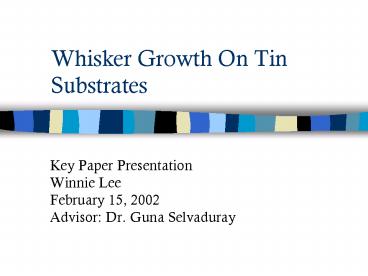Whisker Growth On Tin Substrates - PowerPoint PPT Presentation
1 / 12
Title:
Whisker Growth On Tin Substrates
Description:
4th International SAMPE Electronics Conference ( June 12-14, 1980) ... 90 Sn-10Pb solder plating. 60 Sn-40 Pb solder plating with hot oil reflow ... – PowerPoint PPT presentation
Number of Views:171
Avg rating:3.0/5.0
Title: Whisker Growth On Tin Substrates
1
Whisker Growth On Tin Substrates
- Key Paper Presentation
- Winnie Lee
- February 15, 2002
- Advisor Dr. Guna Selvaduray
2
Outline of Presentation
- Introduction
- Experimental Method
- Results
- Evaluation of Results
- Discussion of Experimental Methodology
- Analysis of Results
- Relation to My Work
3
Introduction
- Conference Proceeding
- 4th International SAMPE Electronics Conference (
June 12-14, 1980) - Tin Whiskers Mechanism of Growth and
Prevention by Kathleen M. Cunningham and Michael
P. Donahue - Affiliated with Raytheon Company Missile Systems
Laboratories
4
Introduction (Motivation For Study)
- Tin coatings offer many excellent properties
- Tin whiskers can grow from tin coatings and
platings - May cause electrical failures in working devices
- Affect product reliability and service life
5
Experimental Method
- Samples
- - 6061 Aluminum QQ-A-250 as base material
- - Copper underplating
- 4 different plating systems
- Pure tin electroplate
- Hot tin dip coating
- 90 Sn-10Pb solder plating
- 60 Sn-40 Pb solder plating with hot oil reflow
6
Experimental Method(Contd)
- Samples were assembled on a test module unit
- Unit was exposed at a temperature of 93C
- A torque of 72.13 meters-grams was applied on
unit - Electrical testing done on unit
- If electrical short was recorded, unit was
disassembled to check for tin whiskers
7
Results of Testing
- Optical microscope and SEM were used
- 2 types of whiskers found nodular filament
- Whiskers formed ridge and cluster
- Whiskers found in areas where mechanical stresses
were applied - No whiskers found on 60Sn-40Pb plating with hot
oil reflow
8
(A) Discussion On Method
- Plating systems satisfied basic criteria for tin
plating replacements - Temperature and torque were chosen respectively
as they yield highest density of whiskers - Electrical testing was a good approach to check
for presence of whiskers
9
(A) Discussion On Method(Contd)
- Unit was only disassembled when electrical short
was recorded - - Whiskers do not always cause shorts
- One more test unit should be included
- - An additional set of parameters available
- Time interval between testing of samples is
unknown
10
(B) Analysis Of Results
- Results obtained were pertinent to study
- Highest density of whisker growth discovered
- Types of whiskers were found
- Time taken for electrical short to occur was
recorded - Correlation between mechanical stress, heat and
whisker growth
11
Relation To My Work
- Goals of my project Determine driving force(s)
and growth mechanism of tin whiskers - Tin dip coating of copper samples
- Application of mechanical stresses and exposure
to elevated temperatures - Positive results yielded!!
12
Conclusion
- Study related to my work
- Results are positive
- Alternative methodology discovered































